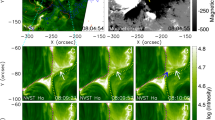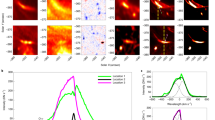Abstract
In the standard model of solar flares, a large-scale reconnection current sheet is postulated to be the central engine for powering the flare energy release1,2,3 and accelerating particles4,5,6. However, where and how the energy release and particle acceleration occur remain unclear owing to the lack of measurements of the magnetic properties of the current sheet. Here we report the measurement of the spatially resolved magnetic field and flare-accelerated relativistic electrons along a current-sheet feature in a solar flare. The measured magnetic field profile shows a local maximum where the reconnecting field lines of opposite polarities closely approach each other, known as the reconnection X point. The measurements also reveal a local minimum near the bottom of the current sheet above the flare loop-top, referred to as a ‘magnetic bottle’. This spatial structure agrees with theoretical predictions1,7 and numerical modelling results. A strong reconnection electric field of about 4,000 V m−1 is inferred near the X point. This location, however, shows a local depletion of microwave-emitting relativistic electrons. These electrons instead concentrate at or near the magnetic bottle structure, where more than 99% of them reside at each instant. Our observations suggest that the loop-top magnetic bottle is probably the primary site for accelerating and confining the relativistic electrons.
This is a preview of subscription content, access via your institution
Access options
Access Nature and 54 other Nature Portfolio journals
Get Nature+, our best-value online-access subscription
$29.99 / 30 days
cancel any time
Subscribe to this journal
Receive 12 digital issues and online access to articles
$119.00 per year
only $9.92 per issue
Buy this article
- Purchase on Springer Link
- Instant access to full article PDF
Prices may be subject to local taxes which are calculated during checkout




Similar content being viewed by others
Data availability
The data that support the plots within this paper and other findings are available at http://ovsa.njit.edu (EOVSA), https://hesperia.gsfc.nasa.gov (RHESSI) and http://jsoc.stanford.edu (SDO), or from the corresponding author upon reasonable request.
Code availability
The microwave spectral fitting software, GSFIT, is available in the community-contributed SolarSoftWare (SSW) repository, under the packages category, at https://www.lmsal.com/solarsoft/ssw/packages/gsfit. Fast gyrosynchrotron codes are available within the GX_simulator package in the SSW distribution at https://www.lmsal.com/solarsoft/ssw/packages/gx_simulator. Codes for calculating the theoretical magnetic model are available from the corresponding author upon reasonable request. Public software packages utilized in this study include SunCASA (https://github.com/suncasa/suncasa), CASA39 (https://casa.nrao.edu), SunPy40 (https://sunpy.org), Astropy41 (https://www.astropy.org), Athena++34 (https://princetonuniversity.github.io/athena), emcee48 (https://emcee.readthedocs.io), and LMFIT (https://lmfit.github.io/lmfit-py).
References
Lin, J. & Forbes, T. G. Effects of reconnection on the coronal mass ejection process. J. Geophys. Res. 105, 2375–2392 (2000).
Masuda, S., Kosugi, T., Hara, H., Tsuneta, S. & Ogawara, Y. A loop-top hard X-ray source in a compact solar flare as evidence for magnetic reconnection. Nature 371, 495–497 (1994).
Shibata, K. & Magara, T. Solar flares: magnetohydrodynamic processes. Living Rev. Sol. Phys. 8, 6 (2011).
Litvinenko, Y. E. Particle acceleration in reconnecting current sheets with a nonzero magnetic field. Astrophys. J. 462, 997–1004 (1996).
Drake, J. F., Swisdak, M., Che, H. & Shay, M. A. Electron acceleration from contracting magnetic islands during reconnection. Nature 443, 553–556 (2006).
Bárta, M., Büchner, J., Karlický, M. & Skála, J. Spontaneous current-layer fragmentation and cascading reconnection in solar flares. I. model and analysis. Astrophys. J. 737, 24 (2011).
Forbes, T. G., Seaton, D. B. & Reeves, K. K. Reconnection in the post-impulsive phase of solar flares. Astrophys. J. 858, 70 (2018).
Gary, D. E. et al. Microwave and hard X-ray observations of the 2017 September 10 solar limb flare. Astrophys. J. 863, 83 (2018).
Morosan, D. E. et al. Multiple regions of shock-accelerated particles during a solar coronal mass ejection. Nat. Astron. 3, 452–461 (2019).
Yan, X. L. et al. Simultaneous observation of a flux rope eruption and magnetic reconnection during an X-class solar flare. Astrophys. J. 853, L18 (2018).
Veronig, A. M. et al. Genesis and impulsive evolution of the 2017 September 10 coronal mass ejection. Astrophys. J. 868, 107 (2018).
Chen, B., Yu, S., Reeves, K. K. & Gary, D. E. Microwave spectral imaging of an erupting magnetic flux rope: implications for the standard solar flare model in three dimensions. Astrophys. J. Lett. 895, L50 (2020).
Warren, H. P. et al. Spectroscopic observations of current sheet formation and evolution. Astrophys. J. 854, 122 (2018).
Longcope, D., Unverferth, J., Klein, C., McCarthy, M. & Priest, E. Evidence for downflows in the narrow plasma sheet of 2017 September 10 and their significance for flare reconnection. Astrophys. J. 868, 148 (2018).
Priest, E. & Forbes, T. Magnetic Reconnection: MHD Theory and Applications (Cambridge Univ. Press, 2000).
Qiu, J., Lee, J., Gary, D. E. & Wang, H. Motion of flare footpoint emission and inferred electric field in reconnecting current sheets. Astrophys. J. 565, 1335–1347 (2002).
Régnier, S., Priest, E. R. & Hood, A. W. Coronal Alfvén speeds in an isothermal atmosphere. I. Global properties. Astron. Astrophys. 491, 297–309 (2008).
Zharkova, V. V. & Agapitov, O. V. The effect of magnetic topology on particle acceleration in a three-dimensional reconnecting current sheet: a test-particle approach. J. Plasma Phys. 75, 159–181 (2009).
Sui, L. & Holman, G. D. Evidence for the formation of a large-scale current sheet in a solar flare. Astrophys. J. Lett. 596, L251–L254 (2003).
Liu, W., Petrosian, V., Dennis, B. R. & Jiang, Y. W. Double coronal hard and soft X-ray source observed by RHESSI: evidence for magnetic reconnection and particle acceleration in solar flares. Astrophys. J. 676, 704–716 (2008).
Narukage, N., Shimojo, M. & Sakao, T. Evidence of electron acceleration around the reconnection X-point in a solar flare. Astrophys. J. 787, 125 (2014).
Krucker, S. et al. Hard X-ray emission from the solar corona. Astron. Astrophys. Rev. 16, 155–208 (2008).
Somov, B. V. & Kosugi, T. Collisionless reconnection and high-energy particle acceleration in solar flares. Astrophys. J. 485, 859–868 (1997).
Li, X., Guo, F., Li, H. & Li, S. Large-scale compression acceleration during magnetic reconnection in a low-β plasma. Astrophys. J. 866, 4 (2018).
Zhou, X., Büchner, J., Bárta, M., Gan, W. & Liu, S. Electron acceleration by cascading reconnection in the solar corona. I. Magnetic gradient and curvature drift effects. Astrophys. J. 815, 6 (2015).
Fleishman, G. D. et al. Decay of the coronal magnetic field can release sufficient energy to power a solar flare. Science 367, 278–280 (2020).
Chen, B. et al. Particle acceleration by a solar flare termination shock. Science 350, 1238–1242 (2015).
Kong, X. et al. The acceleration and confinement of energetic electrons by a termination shock in a magnetic trap: an explanation for nonthermal loop-top sources during solar flares. Astrophys. J. 887, L37 (2019).
Zharkova, V. V. et al. Recent advances in understanding particle acceleration processes in solar flares. Space Sci. Rev. 159, 357–420 (2011).
Nykyri, K., Chu, C., Ma, X., Fuselier, S. A. & Rice, R. First MMS observation of energetic particles trapped in high-latitude magnetic field depressions. J. Geophys. Res. 124, 197–210 (2019).
Priest, E. R. & Forbes, T. G. Magnetic field evolution during prominence eruptions and two-ribbon flares. Sol. Phys. 126, 319–350 (1990).
Forbes, T. G. & Priest, E. R. Photospheric magnetic field evolution and eruptive flares. Astrophys. J. 446, 377–389 (1995).
Reeves, K. K. & Forbes, T. G. Predicted light curves for a model of solar eruptions. Astrophys. J. 630, 1133–1147 (2005).
Stone, J. M., Gardiner, T. A., Teuben, P., Hawley, J. F. & Simon, J. B. Athena: a new code for astrophysical MHD. Astrophys. J. Suppl. 178, 137–177 (2008).
Jiang, C. et al. Magnetohydrodynamic simulation of the X9.3 flare on 2017 September 6: evolving magnetic topology. Astrophys. J. 869, 13 (2018).
Wang, H. et al. Strong transverse photosphere magnetic fields and twist in light bridge dividing delta sunspot of active region 12673. Res. Not. Am. Astron. Soc. 2, 8 (2018).
Ye, J., Shen, C., Raymond, J. C., Lin, J. & Ziegler, U. Numerical study of the cascading energy conversion of the reconnection current sheet in solar eruptions. Mon. Not. R. Astron. Soc. 482, 588–605 (2019).
Dahlin, J. T., Drake, J. F. & Swisdak, M. The role of three-dimensional transport in driving enhanced electron acceleration during magnetic reconnection. Phys. Plasmas 24, 092110 (2017).
McMullin, J. P., Waters, B., Schiebel, D., Young, W. & Golap, K. in Astronomical Data Analysis Software and Systems XVI (eds Shaw, R. A. et al.) 127–130 (2007).
The SunPy Community et al. The SunPy project: open source development and status of the version 1.0 core package. Astrophys. J. 890, 68 (2020).
The Astropy Collaboration et al. The Astropy project: building an open-science project and status of the v2.0 core package. Astron. J. 156, 123 (2018).
Dulk, G. A. & Marsh, K. A. Simplified expressions for the gyrosynchrotron radiation from mildly relativistic, nonthermal and thermal electrons. Astrophys. J. 259, 350–358 (1982).
Fleishman, G. D. & Kuznetsov, A. A. Fast gyrosynchrotron codes. Astrophys. J. 721, 1127–1141 (2010).
Ramaty, R. Gyrosynchrotron emission and absorption in a magnetoactive plasma. Astrophys. J. 158, 753–770 (1969).
Gary, D. E. & Hurford, G. J. in Solar and Space Weather Radiophysics (eds Gary, D. E. & Keller, C. U.) 71–87 (Springer, 2004).
Fleishman, G. D., Nita, G. M. & Gary, D. E. Dynamic magnetography of solar flaring loops. Astrophys. J. 698, L183–L187 (2009).
Gary, D. E., Fleishman, G. D. & Nita, G. M. Magnetography of solar flaring loops with microwave imaging spectropolarimetry. Sol. Phys. 288, 549–565 (2013).
Foreman-Mackey, D., Hogg, D. W., Lang, D. & Goodman, J. emcee: the MCMC hammer. Publ. Astron. Soc. Pac. 125, 306–312 (2013).
Goodman, J. & Weare, J. Ensemble samplers with affine invariance. Commun. Appl. Math. Comput. Sci. 5, 65–80 (2010).
Kuridze, D. et al. Mapping the magnetic field of flare coronal loops. Astrophys. J. 874, 126 (2019).
Anfinogentov, S. A., Stupishin, A. G., Mysh’yakov, I. I. & Fleishman, G. D. Record-breaking coronal magnetic field in solar active region 12673. Astrophys. J. 880, L29 (2019).
Lemen, J. R. et al. The Atmospheric Imaging Assembly (AIA) on the Solar Dynamics Observatory (SDO). Sol. Phys. 275, 17–40 (2012).
O’Dwyer, B., DelZanna, G., Mason, H. E., Weber, M. A. & Tripathi, D. SDO/AIA response to coronal hole, quiet Sun, active region, and flare plasma. Astron. Astrophys. 521, A21 (2010).
Savage, S. L., McKenzie, D. E., Reeves, K. K., Forbes, T. G. & Longcope, D. W. Reconnection outflows and current sheet observed with HINODE/XRT in the 2008 April 9 ‘cartwheel CME’ flare. Astrophys. J. 722, 329–342 (2010).
Savage, S. L. & McKenzie, D. E. Quantitative examination of a large sample of supra-arcade downflows in eruptive solar flares. Astrophys. J. 730, 98 (2011).
Acknowledgements
EOVSA operation is supported by NSF grant AST-1910354. The work is supported partly by NASA DRIVE Science Center grant 80NSSC20K0627. B.C., D.E.G., G.D.F., G.M.N. and S.Y. are supported by NASA grants NNX17AB82G, 80NSSC18K1128, 80NSSC19K0068, 80NSSC18K0667 and NSF grants AGS-1654382, AGS-1723436, AST-1735405, AGS-1743321 and AGS-1817277 to the New Jersey Institute of Technology. K.K.R. and C.S. are supported by NASA grants NNX17AB82G and 80NSSC19K0853 and NSF grants AGS-1723425, AGS-1723313 and AST-1735525 to the Smithsonian Astrophysical Observatory. F.G. is supported by NSF grant AST-1735414 and DOE grant DE-SC0018240. S.K. is supported by NASA contract NAS 5-98033 for RHESSI. J.L. is supported by the Strategic Priority Research Program of the Chinese Academy of Sciences with grants XDA17040507, QYZDJ-SSWSLH012 and XDA15010900, NSFC grant 11933009, the project of the Group for Innovation of Yunnan Province grant 2018HC023, and the Yunnan Yunling Scholar Project. X.K. is supported by NSFC grants 11873036 and 11790303, the Young Elite Scientists Sponsorship Program by CAST, and the Young Scholars Program of Shandong University. The MHD simulations performed for this work were conducted on the Smithsonian High Performance Cluster of the Smithsonian Institution, and used resources of the National Energy Research Scientific Computing Center.
Author information
Authors and Affiliations
Contributions
B.C. conceived the study, carried out the data reduction, analysis, interpretation and manuscript preparation. C.S. performed the MHD simulation and contributed to the observation–modelling comparison. D.E.G. led the construction and operation of EOVSA, and contributed to the microwave data calibration and interpretation. K.K.R. provided codes for the theoretical magnetic model and contributed to the observation–modelling comparison. G.D.F. provided codes for calculating gyrosynchrotron radiation and contributed to microwave spectral fitting. S.Y. contributed to microwave data calibration and EUV data analysis. S.K. performed hard X-ray imaging and contributed to the interpretation of data. J.L. contributed to MHD simulation. F.G. and X.K. contributed to the interpretation of data. G.M.N. contributed to microwave spectral fitting. All authors discussed the results and contributed to manuscript preparation.
Corresponding author
Ethics declarations
Competing interests
The authors declare no competing interests.
Additional information
Publisher’s note Springer Nature remains neutral with regard to jurisdictional claims in published maps and institutional affiliations.
Extended data
Extended Data Fig. 1 Magnetic modelling of the X8.2 eruptive solar flare event on 2017 September 10.
a, Representative magnetic field lines from the theoretical standard flare model of Lin & Forbes1. b, and c, Results from the numerical resistive two-and-half-dimensional MHD model in the weak and strong guide field Bz case, respectively. Background is SDO/AIA time-series images of the EUV 211-Å filter band. The thin vertical structure with red-orange colour near x = 0 Mm is the RCS with an enhanced electric current density jz. The first panel in each row shows the initial conditions of the magnetic modeling, which consist of a line current that represents the magnetic flux rope (red circle symbol) and a pair of bipolar magnetic sources at the solar surface (point sources in theoretical model and line sources in MHD).
Extended Data Fig. 2 Magnetic field variation across and along the RCS in the MHD simulation.
a, Enlarged view of the central RCS region in the MHD model (white box in the right panels of Extended Data Fig. 1b,c). The RCS exhibits itself as the vertical feature with a strong current density jz. b, Height variation of the total magnetic field strength B(y) along the RCS (at x = 0 Mm; vertical dashed line in a). Dashed and dotted curves represent results from the full-resolution MHD model at x = 0 Mm and x = 1 Mm. Solid curve is the B(y) profile obtained after convolution with EOVSA’s instrument resolution. The latter contains key information about the average magnetic field in the immediate vicinity of the RCS (same as the red curve in Fig. 3b), which compares favorably with results derived from EOVSA microwave observations. c, Spatial variation of the x, y, z components of the magnetic field vector across the RCS (Bx(x), By(x), Bz(x)) obtained at y = 31 Mm (horizontal line in a). d, Total magnetic field variation across the RCS B(x). Dashed and solid curves show, respectively, the result from the full-resolution MHD model and that after convolution with EOVSA instrument resolution. Note the sharp dip at the very center of the current sheet is smoothed out. (e)–(h) Same as above, but for the stronger guide field Bz case.
Extended Data Fig. 3 MCMC analysis for an example spatially resolved microwave spectrum.
The spectrum is taken from the location labelled ‘2’ in Fig. 2c. Red lines/circles in each panel indicate the final fit results from the MCMC analysis. Corresponding spectra and residuals calculated from each MCMC sampling in the multi-parameter space are shown in the upper right panel as grey curves. Red curves are the final fit spectrum and residual. Note the total number density of energetic electrons shown in the corner plot is the result integrated above 100 keV (\({n}_{e}^{ \,{>}\,100}\)), which is different from the value of \({n}_{e}^{ \,{>}\,300}\) shown in Fig. 2d.
Extended Data Fig. 4 MCMC analysis for an example spatially resolved microwave spectrum with two spectral components.
The spectrum is taken from the location labelled ‘3’ in Fig. 2c. The corner plots are similar to Extended Data Fig. 3, but they show MCMC results with two source components. Parameters with subscripts ‘1’ and ‘2’ indicate the physical parameter for the two components, respectively. Red curve and dashed black curve in the upper right panel shows, respectively, the fit spectrum with both components and the spectrum calculated from the component with a stronger magnetic field only (that is, component with subscript ‘1’).
Supplementary information
Supplementary Video 1
Animation accompanying Fig. 4. The animation shows the flare evolution from 15:51:45 UT to 16:06:09 UT on 2017 September 10. Panels a and c are identical to those in Fig. 4. Panel b shows SDO/AIA 171-Å running-ratio time-series images. Examples of the plasma inflows converging towards the RCS from the − x and + x sides are marked in the x − t plot in a as blue and red curves and in b as triangles with the same colour. Plasma downflows below the RCS are marked as green curves in the t − y plot in c and in b as green triangles. The moving horizontal/vertical bar in panels a/c indicates the corresponding time.
Rights and permissions
About this article
Cite this article
Chen, B., Shen, C., Gary, D.E. et al. Measurement of magnetic field and relativistic electrons along a solar flare current sheet. Nat Astron 4, 1140–1147 (2020). https://doi.org/10.1038/s41550-020-1147-7
Received:
Accepted:
Published:
Issue Date:
DOI: https://doi.org/10.1038/s41550-020-1147-7
This article is cited by
-
Detection of long-lasting aurora-like radio emission above a sunspot
Nature Astronomy (2023)
-
Numerical MHD Simulations of Reconnection in Solar Flares: Effects of the Magnetic-Field Strength in the Current Sheet
Solar Physics (2023)
-
Non-thermal electron acceleration from magnetically driven reconnection in a laboratory plasma
Nature Physics (2023)
-
The origin of underdense plasma downflows associated with magnetic reconnection in solar flares
Nature Astronomy (2022)
-
Microwave imaging of quasi-periodic pulsations at flare current sheet
Nature Communications (2022)



